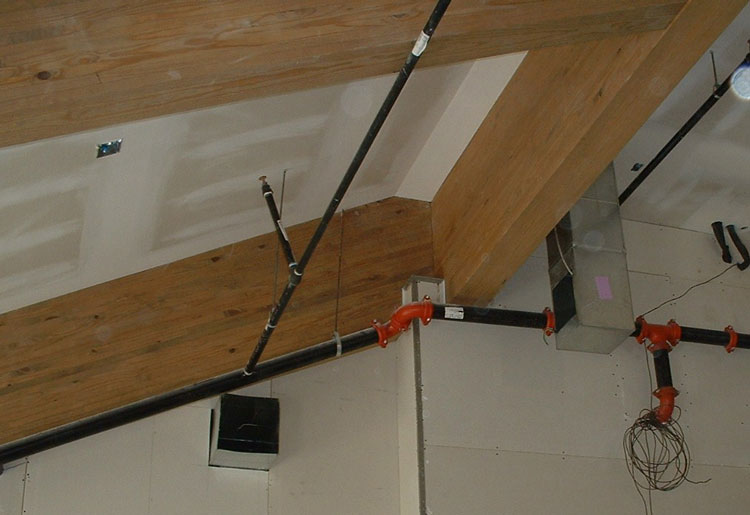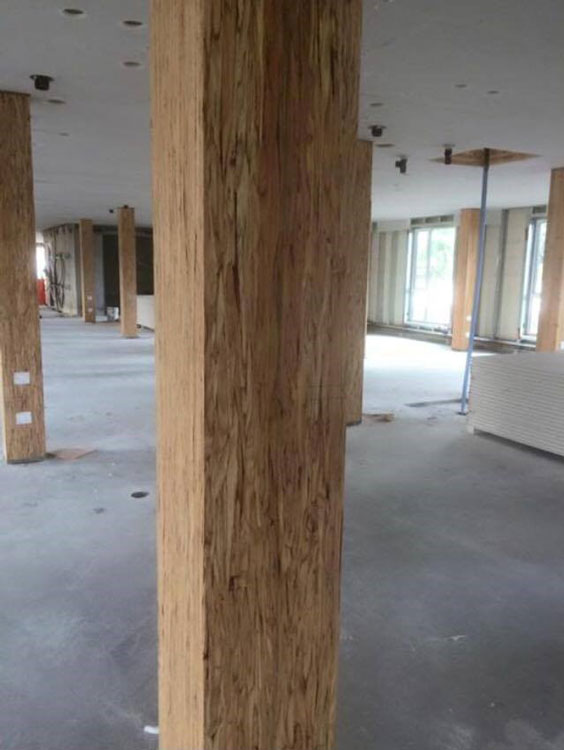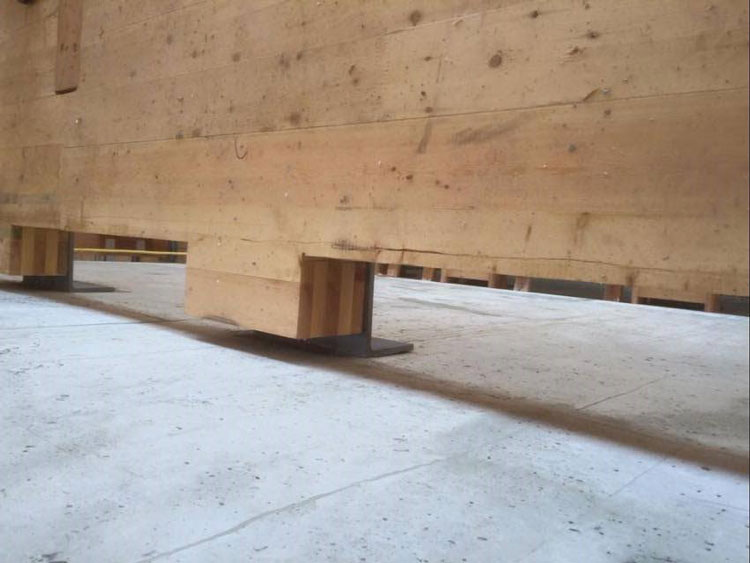
By Greg Havel
Photos by James Johnson, Vancouver (BC) Fire Department
The present edition of the International Building Code (IBC) limits heavy timber buildings to 85 feet in height. The tallest mass-timber building in the western hemisphere is the Brock Commons residence hall at the University in Vancouver, British Columbia, Canada. Had the Brock Commons at 190 feet in height been subject to the current IBC, it could not have been built. Photo 1 shows part of one floor of the Brock Commons, with some mass timber surfaces protected by gypsum drywall board.
For more than two years before submitting proposals, the International Code Council’s (ICC) committee on tall wood buildings has studied mass timber construction, including both engineering studies and fire performance tests. The committee seems confident that the fire and life safety performance concerns have been addressed in the proposals.

(1)

(2)

(3)
The ICC committee proposes three new sub-types of Type IV (heavy timber) in the 2021 edition of the IBC. Each has different height limits based on the occupancy classification and design criteria. The structural elements are composed of solid, panelized, engineered, built-up wood products such as cross-laminated timber (photo 2), glulams (photo 3), and similar products. None of the new types permit the use of lightweight construction materials like wooden I-joists or wooden trusses.
- Type IV-A residential and office buildings would have three-hour-rated wood structural components completely enclosed in gypsum drywall board, with no exposed wood structural surfaces. It would allow a maximum height of 18 stories, which is equivalent to 270 feet.
- Type IV-B residential and office buildings would have two-hour rated wood structural components mostly but not entirely enclosed with gypsum drywall board. It would allow a maximum height of 12 stories, which is equivalent to 180 feet.
- Type IV-C residential and office buildings would have two-hour rated wood structural components completely exposed with no drywall board enclosures. It would allow a maximum height of nine stories and 85 feet.
At the ICC’s final action hearings on October 24, 2018, code officials voted 220 to 103 to increase the height limits for mass timber buildings. ICC’s two weeks of online voting on the mass timber proposals ended in late November 2018, with the preliminary results to be announced in December 2018.
After the ICC’s Technical Activities Committee reviews the proposals and a third-party audit of the online voting, the official results of the online vote will be announced. The Technical Activities Committee will then file its report and recommendations to the ICC Standards Board. This Standards Board will determine whether the proposed mass timber changes to the International Building Code will be included in the 2021 edition.
The Engineering News Record website https://www.enr.com/ is a good source of information on both proposed and approved changes to building codes.
If these proposals are included in the IBC 2021, and if our state or municipal government adopts the new edition of the IBC in its entirety, we may find ourselves in a few years fighting fires in combustible high-rise buildings. Even if our state or municipality chooses not to permit buildings of these new types, we may respond under a mutual aid agreement to a community that does permit them. It is not too soon to begin reviewing our current operational procedures and drafting the modifications that these new buildings will require.
- We may find that we are fighting fires in the upper floors of combustible buildings beyond the reach of our tallest aerial apparatus.
- We may find ourselves more dependent than ever on fixed fire protection systems like automatic fire sprinkler and extinguisher systems, and on standpipes of various types.
- We may find ourselves dependent on the proper functioning of fire pumps that are part of the building’s equipment, rather than only dependent on the fire pumps on automotive fire apparatus
- We may find that our fire inspectors and fire marshals will need more specialized training to ensure that these systems are maintained according to National Fire Protection Association codes and standards, so that they will be reliable when they are needed.
- We may find that our firefighters and fire officers need more specialized training to effectively use these systems when they respond to a fire alarm at one of these buildings
- We may find that we need more detailed preincident plans for buildings like these, and for the occupancies located in them, than we have in place for many of our present buildings
If we wish to avoid increasing the incidence of firefighter injuries and fatalities in these unfamiliar structures, we will find that the presence of buildings like the proposed Type IV-A, IV-B, and IV-C, will require more planning, and more education and training for fire department personnel.
Download this article as a PDF HERE.
 Gregory Havel is a member of the Town of Burlington (WI) Fire Department; a retired deputy chief and training officer; and a 40-year veteran of the fire service. He is a Wisconsin-certified fire instructor II, fire officer II, and fire inspector; an adjunct instructor in fire service programs at Gateway Technical College; and safety director for Scherrer Construction Co., Inc. Havel has a bachelor’s degree from St. Norbert College, has more than 40 years of experience in facilities management and building construction, has a Chief Power Plant Operating Engineer license from the American Society of Power Engineers (ASOPE), and presents classes at FDIC and other venues.
Gregory Havel is a member of the Town of Burlington (WI) Fire Department; a retired deputy chief and training officer; and a 40-year veteran of the fire service. He is a Wisconsin-certified fire instructor II, fire officer II, and fire inspector; an adjunct instructor in fire service programs at Gateway Technical College; and safety director for Scherrer Construction Co., Inc. Havel has a bachelor’s degree from St. Norbert College, has more than 40 years of experience in facilities management and building construction, has a Chief Power Plant Operating Engineer license from the American Society of Power Engineers (ASOPE), and presents classes at FDIC and other venues.
MORE CONSTRUCTION CONCERNS

